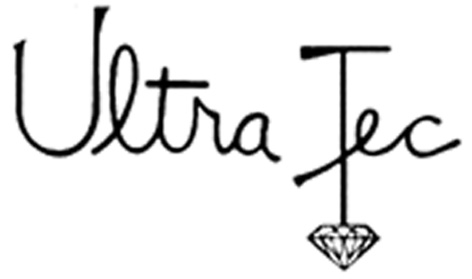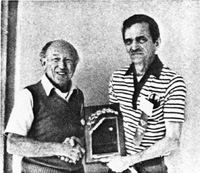|
|
|
|
|
The Ultra Tec Owners' Newsletter
March 1984
"The Some Times"
|

|
|
Dear Ultra Tec Owner,
If my memory serves me right, I started a newsletter this time
last year with some poetic comment about "the crack of baseball
bats reminding me...", etc. Well, last Saturday as I sat in the
warm sun (obviously here in California)-, watching my son play
his first baseball game of the year and that bit of poetry
popped back into my head. and I was reminded what Springtime
means: Spring Newsletter --and there I was just sitting back
and relaxing. Guilt lost out that day.
Today, driven by guilt or whatever, I'm ready.
For those of you who purchased an Ultra Tec fairly recently
(or who asked to get on the mailing list), you are herewith
receiving your first Owners' Newsletter. We write sometimes,
usually two or three times a year. We write a bit of news,
some faceting hints, a gem diagram and I get a chance to pop
off. We certainly welcome ideas from you that can be passed
along-so if you have come up with some good technique (even
a minor one), tell us.
Since the last newsletter we attended three shows--the Facetors
Fair given by the Southern California Facetors' Guild, the
International Facetors Fair in San Jose, and the annual big
show at Tucson. Going to the shows means a lot of hauling out
of display materials, travel and long hours on the show floor,
but we feel it is well compensated for by the chance to meet
the Ultra Tec "family", share some faceting ideas and talk to
people who are thinking about getting into faceting.
One of the interesting bits of show activity occurred at a show
we didn't manage to attend--the California Federation Show. There,
the particularly interesting event was the winning of the traditional
O'Brien Trophy by Anthony Agnello, an Ultra Tec facetor who lives
in Michigan (yes, Michigan). In our last letter we talked bout Mr.
Agnello's success in competition and now he has continued his winning
ways, entering shows by mail, a long way from home. In addition to the
O'Brien Trophy he won another West Coast award at the Southern
California Facetors' Fair in the Best Three Stone competition.
We send Anthony Agnello our congratulations.
And to those of you "on the competitive fence", let it be a
lesson, TRY IT! Even if you do not win, it will be educational
since the judges will note their observations of your submitted
stones. It was for that latter reason that Anthony, a self-taught
facetor, tried competition in the first place. And see what
happened.
If you are looking for a good competition to enter, check out the
information on the Big Sky Facetors Show(it is enclosed with this
letter).
|
|

|
Back to the shows that were. This year's winner of the
Ultra Tec Award for the Best Case at the International
Facetors Fair in San Jose was Bill Olsen of nearby
Santa Clara. Bill did the work on a machine he built
- and an explanation is in order that he is a master
machinist working as a model maker in the Bay Area. Bill,
who has been faceting for 20 years, is a member of the
Campbell Rock Club, so, many congratulations to Bill. He
will be cutting the Ultra Tec Trophy Stone for next year's
award, continuing the tradition.
|
|
At the same show the Masters Trophy was won by Vern Johnson -
it's a single stone competition--which ended with four
competitors having scores ranging from 98.75 to 100! How would
you like to be a judge in that one? Next year the required
stone is Topaz. So you competitors out there, who would like
a prestigious competition without having to prepare many stones,
this is a good one to try (and you bet, the competition is tough).
Just a last word about competition. We always do write about
"the winner". In faceting, however, the most important aspect
of competition (although no one talks much about it) is
competing with yourself--much as a runner is interested in his
own personal running time. We have seen competitions in which
99.5 places third and competitions where 80 placed first. We
think that the most important part of it all is learning about
your own faceting, so you can take the next step of improvement.
In competition you learn from expert judges just where your
stones could be better (even your best friends won't tell you).
In twelve years of watching competitions, I've never seen
anyone "put down" for a relatively low score. I have seen people
with low scores gain understanding and come back later with very
high scores (as a matter of fact, almost always). You might find
you are better than you thought. I know competition is not for
everyone, but if shyness or nervousness is keeping you out, take
a breath and overcome it. The payback is worth it.
WHAT'S NEW?
As the showbiz folks say, "In response to popular demand!..."
Ultra Tec now has an improved Angle Dial readout. Hardly increasing
the outside size of it, the angular spacings have been increased 30%.
That makes it even easier on the eyes and consequently improves
repeatability. The increase in size makes it equivalent to a 12
inch diameter protractor. While we were at it we made the vernier
readout in .1° increments, a bit more comfortable when working with
gem diagrams that come off the computer.
The working parts of the Angle Dial have not been changed - we had no
desire to tamper with the proven reliability of the Angle Dial. The
ball bearings, the anti-backlash spring, the gearing,--the "heart and
muscles" of the device are the same. It is the readout that has been
improved.
If you think you will want to update your machine with the new Angle
Dial, pay attention to the initial offer. The information is attached.
Something else new is a second volume of Diagrams For Faceting from
Glenn Vargas. It is designated Volume II (making the old Gem Diagrams,
Volume I). If you are like me, you can't have too many designs to
mull over before making a choice for that new piece of gem rough.
This book brings you over 150 diagrams. This Vargas book is a welcome
addition to the faceting library.
We have modified the Facet Saw Kit. The Saw Blade now has a 1/2 inch
arbour hole, providing immediate centring (and eliminating the
manouvering necessitated by the old 5/8 inch hole). If you have an
old adapter with a 5/8" guide diameter, you will find it will work
just fine with the 1/2" diameter saw. If the time comes to replace
the saw blade (and, of course, if you wish), you can send in the
adapter and we will machine it--eliminating the 5/8" step. You pay
the postage and there will be no charge for the machining.
I am sure that this improvement will encourage more use of the
Facet Saw Kit, since it eliminates the bit of hassle with the
5/8" hole. With the ever-increasing price of gem rough the capability
that the Facet Saw Kit offers the facetor--that is, to save useable
cut off material rather than grind it away--is increasingly
welcome. Also, the time saving is worthwhile.
When we first came out with the saw, quite a few years ago, we did
not realize the sort of precise work that some people would put it
to. I remember getting a letter from one of our facetors who said
he was having difficulty sawing in the main facets. Before we
could send back a letter saying that was too ambitious a use of
it, we received another letter from the man saying, "forget my first
letter; I am putting in those mains just fine now." Well, I still
don't try that myself--perhaps I just haven't gotten up the nerve,
but I sure make good use of the Facet Saw Kit and I find it a great
pleasure to get that extra little stone from my gem rough.
There are a few things in the "faceting hints file":
A facetor, who spoke to us in Tucson, suggested this method for
initial dopping of the stone, that is, aligning the stone on the
first dop: Hold the bottom side of the rough stone (the portion
destined to be the pavilion) on a dop, attached opposite the dop
you will be cementing to, with modelling clay. Then, if you place
it into a transfer fixture, you can move the stone around in the
clay until you determine the best alignment. Then apply whatever
dopping cement you use. That might save you a few redoppings.
A why-didn't-we-think-of-that idea was called in by John Gullach.
He suggested the use of an Allen Head screw (a hex type) to hold
in the Gear Segment (the detent) replacing the slotted head.
Unlike a screw driver, the Allen Wrench holds the screw and you
have a hand free to hold the Segment and the Spacer. Good idea -
we are putting an Allen Screw on new machines now (if you send
in for something - ask us for one). Of course, expect a big sale
on slotted head screws.
Someone told us that he freezes dops in order to clean them - and
the old wax pops off easily.
Bob Tobi offered a suggestion for realignment of a stone that may
have moved or come off the dop while polishing. After redopping you
can check the facet position as follows:
1. Place a small piece of soft paper on the lap. One or two
square inches is sufficient.
2. Lower the stone to make an impression on the paper. A perfectly
aligned stone will make an impression that is the same size and
shape as the facet. The impression of a misaligned facet may be
a point, a line caused by one of the edges of a facet, or an
angular impression resulting from two intersecting edges of the facet.
3. If the facet is not flat on the lap inspect both the impression
and the facet. Decide whether to raise or lower the facet head and
whether or not the cheater needs to be adjusted. It may take several
adjustments before a true impression of the facet can be made on the paper.
4. When the facet is aligned continue polishing.
5. Repeat the procedure for each facet to be polished.
|
This procedure takes surprisingly little time. It is especially helpful
when aligning or polishing small facets that are difficult to see.
It is also useful when a stone is redopped to refinish a facet.
Thank you, Bob.
Coming soon--really--is a new Owners' Manual. We are down to the final
details. We will have more information about that in our next
newsletter. Until then - we send you our best regards.
Sincerely,
|
| : |

|
Return to the
Ultra tec Newsletter Page
|
All content including images and text remain the
property of UltraTec.
Copyright © Ultra Tec 1993
|


